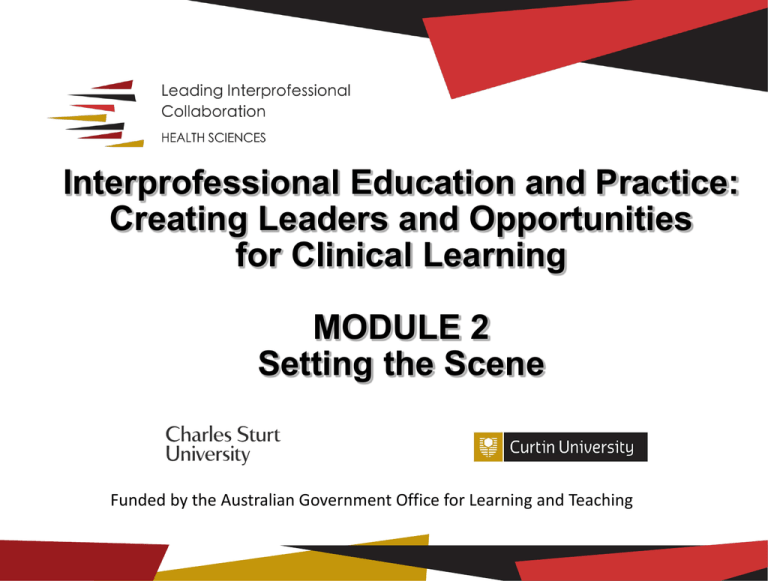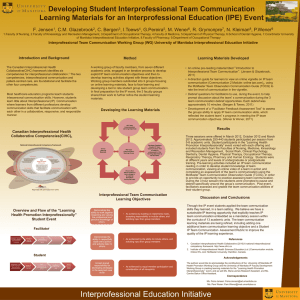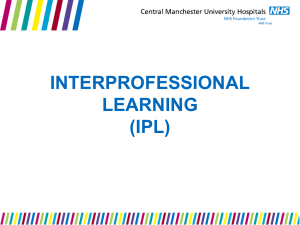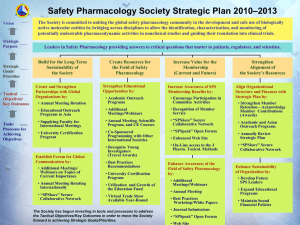Module 2: Setting the scene
advertisement

Interprofessional Education and Practice: Creating Leaders and Opportunities for Clinical Learning MODULE 2 Setting the Scene Funded by the Australian Government Office for Learning and Teaching Learning outcomes • Define both interprofessional education and interprofessional practice • Demonstrate an understanding of the education/practice continuum • Examine the evidence for interprofessional education Advancing interprofessional education and practice in Australia Interprofessional Education Interdependent Interprofessional Practice (© University of Toronto ehpic™, 2013) Romanow (2002) “If health care providers are expected to work together and share expertise in a team environment, it makes sense that their education and training should prepare them for this type of working arrangement.” The cartoon “CIHC Campus: How can they work together if they don’t learn together?” (CIHC, 2008) Framework for action on interprofessional education and collaborative practice Improved Health Outcomes Local Context Health & Education Systems Strengthened Health Systems Collaborative Practice Present & Future Health Workforce Collaborative Practice-Ready Interprofessional Education Optimal Health Services Health Workforce Fragmented Health Systems Local Health Needs (WHO, 2010) Interprofessional education (IPE) “…occurs when two or more professions learn about, from and with each other to enable effective collaboration and improve health outcomes...” (WHO, 2010) Interprofessional practice (IPP) “…occurs when multiple health workers from different professional backgrounds provide comprehensive health services by working with patients, their families, carers & communities to deliver the highest quality of care across settings...” and, “…partnership between a team of health providers and a client in a participatory, collaborative and coordinated approach to shared decision making around health and social issues…” (WHO, 2010) Practice spectrum Uniprofessional Multiprofessional Interprofessional Transprofessional How do multiprofessional, interprofessional and transprofessional practice differ from each other? Education spectrum Uniprofessional Multiprofessional Interprofessional How do multiprofessional and interprofessional education differ from each other? Why now? Shortage of 4.3 million health workers world-wide (Framework for Action on Interprofessional Education & Collaborative Practice. WHO, 2010) Global networks Canadian Interprofessional Health Collaborative American Interprofessional Health Collaborative Centre For The Advancement of Interprofessional Education (UK) AIPPEN Australiasian Interprofessional Practice and Education Network The Network Toward Unity for Health European Interprofessional Education Network in Health & Social Care Nordic Interprofessional Network Japanese Association for Interprofessional Education INTERED The International Association for Interprofessional Education & Collaboration Interprofessional practice (IPP) “…occurs when multiple health workers from different professional backgrounds provide comprehensive health services by working with patients, their families, carers & communities to deliver the highest quality of care across settings…” (WHO, 2010) …across all settings… (© University of Toronto ehpic ™, 2013) Acute Care Primary Care Rehabilitation Care Evidence for interprofessional education • Increased understanding of others role, skills & responsibilities, overlap in knowledge & skills • Altered stereotypical views • Enhanced team working skills • Better sense of how interprofessional collaboration & communication skills grow & develop (Cooper et al., 2001, Reeves et al., 2008) Evidence for interprofessional practice • Greater continuity of care (less fragmented services) • Increased level of critical thinking among health professions • Better access to services & shorter waiting times • Higher levels of well-being amongst staff, greater retention • Collaborative decision-making with patients and family • Better communication • Better patient outcomes, safety and satisfaction • More appropriate referrals • Reduction in duplicity of service, procedures and assessment • Reduced hospital admissions • Improved safety and quality in health care delivery (WHO, 2010) Quality healthcare • Safe - avoiding injuries to patients • Effective - providing services based on scientific knowledge • Patient-centered - providing care that is respectful of, and responsive to, individual patient preferences, needs, and values • Timely - reducing waits and sometimes harmful delays • Efficient - avoiding waste • Equitable - providing care that does not vary in quality because of personal characteristics (Crossing the Quality Chasm. IOM, 2001) Example from Canada http://www.youtube.com/watch?v=JBQIW1xiSO0 National Chronic Disease Strategy “Integrated care means that health services work collaboratively with each other, and with patients and their families and carers, to provide person centred optimal care” The report National Chronic Disease Strategy (NHPAC, 2006) The report National Health Workforce Innovation and Reform Strategic Framework for Action 2011-2015 (HWA, 2011) The report Framework for Action on Interprofessional Education & Collaborative Practice (WHO, 2010) Reality in Australia Client, student & facilitator stories Support for the production of this resource has been provided by the Australian Government Office for Learning and Teaching. The views expressed in this Power Point do not necessarily reflect the views of the Australian Government Office for Learning and Teaching. Unless otherwise noted, content on this site is licensed under the Creative Commons Attribution-ShareAlike 4.0 Unported License











